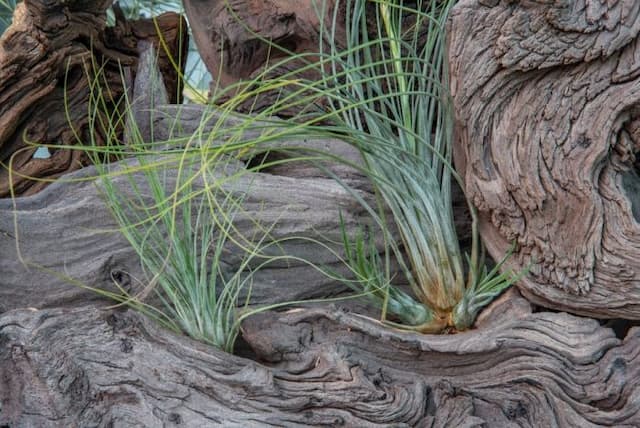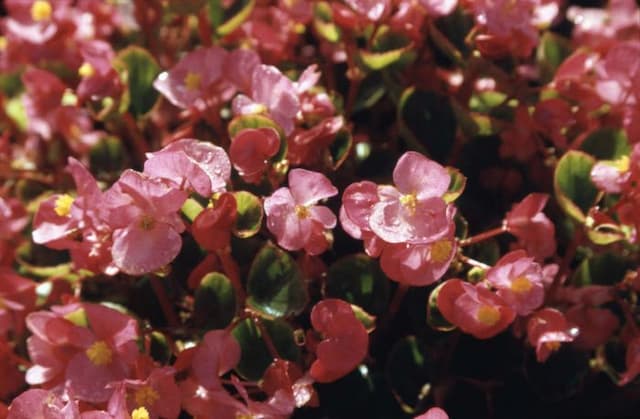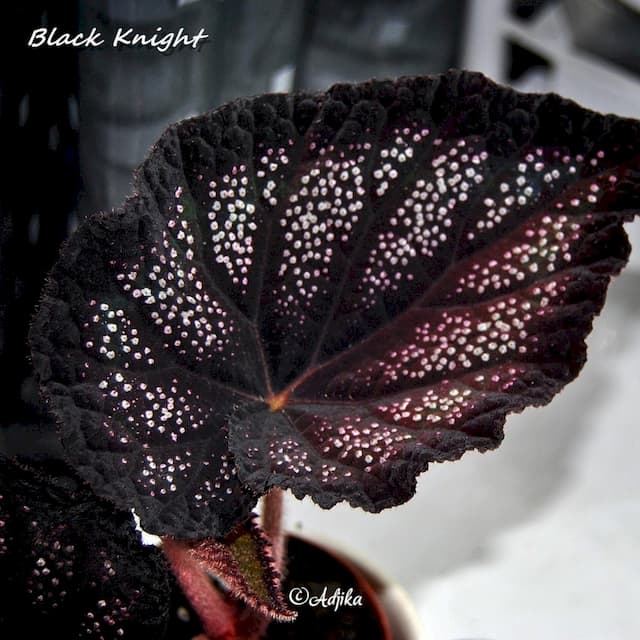Bolivian Begonia Begonia boliviensis (T)

ABOUT
Begonia boliviensis, commonly known as Bolivian Begonia, is a plant known for its distinctive and attractive appearance. Typically, it features fleshy, green leaves which have a subtle, asymmetric, heart shape. The edges of the leaves often have serrated margins, giving them a somewhat jagged look. The foliage can sometimes have a red tint on the undersides, lending additional color and visual interest. The most striking aspect of the Bolivian Begonia is its flowers. They are vibrant and trumpet-shaped, dangling elegantly from the stems. Commonly appearing in bright shades of red, orange, or sometimes pink, these flowers have four delicate petals that flare outwards, creating a wide-open look that is highly attractive to pollinators. A small cluster of reproductive parts is usually visible at the center of the blooms, and the flowers are known for blooming prolifically throughout the warmer months. Overall, the visual appeal of the Bolivian Begonia comes from both its lush foliage and its eye-catching blossoms, which together make it a popular choice for gardeners looking to add a splash of tropical flair to their surroundings.
About this plant
 Names
NamesFamily
Begoniaceae.
Synonyms
Bolivian Begonia, Bonfire Begonia, Santa Cruz Begonia.
Common names
Begonia boliviensis.var.argentinensis, Begonia coriacea, Begonia veitchii, Begonia cucullifera, Begonia boliviensis var. cucullifera.
 Toxicity
ToxicityTo humans
Begonia boliviensis, commonly known as Bolivian Begonia, is not typically considered toxic to humans. However, eating large quantities of begonias, in general, could potentially cause gastrointestinal irritation, including nausea, vomiting, and diarrhea, due to the presence of insoluble oxalates in the plant. It is important to exercise caution and keep begonias out of reach of children who might be tempted to ingest plant parts due to curiosity.
To pets
Bolivian Begonia is also not specifically listed as toxic to pets, but it can cause the same gastrointestinal irritation in pets as in humans if ingested. Symptoms of poisoning in pets can include drooling, vomiting, and diarrhea, which result from irritation caused by insoluble oxalate crystals found in the plant. If ingested by pets, especially in large amounts, it is a good idea to contact a veterinarian.
 Characteristics
CharacteristicsLife cycle
Perennials
Foliage type
Deciduous
Color of leaves
Green
Flower color
Orange
Height
1-2 feet (30-60 cm)
Spread
1-2 feet (30-60 cm)
Plant type
Herb
Hardiness zones
10
Native area
Bolivia
Benefits
 General Benefits
General Benefits- Aesthetic Appeal: Begonia boliviensis, commonly known as Bolivian Begonia, has vibrant and colorful flowers that enhance the visual appeal of gardens and indoor spaces.
- Attracts Pollinators: The bright flowers of Bolivian Begonia can attract butterflies and other pollinators, supporting local ecosystems.
- Versatility in Landscaping: With its upright or cascading habit, it fits well in various garden designs, including containers, hanging baskets, and borders.
- Shade Tolerance: Bolivian Begonia can thrive in shaded areas where other plants might struggle, providing color in less sunny garden spots.
- Drought Tolerance: Once established, it can withstand periods of dryness, requiring less watering compared to some other flowering plants.
- Ease of Care: It is known for being low-maintenance, which is ideal for gardeners of all skill levels.
- Long Blooming Period: It gives a prolonged display of flowers from late spring to frost, ensuring a colorful garden for a significant part of the year.
- Non-Invasive: This plant tends not to be invasive, so it coexists well with other plants without overtaking garden spaces.
 Medical Properties
Medical PropertiesThis plant is not used for medical purposes.
 Air-purifying Qualities
Air-purifying QualitiesThis plant is not specifically known for air purifying qualities.
 Other Uses
Other Uses- Begonia boliviensis, commonly known as Bolivian Begonia, can be used in hanging baskets to add vibrant color and unique bell-shaped flowers to patios and porches.
- The plant's vibrant flowers can serve as natural dye for fabrics, providing a range of red and pink hues depending on the mordant used.
- Its waxy leaves have been utilized in art projects, such as leaf rubbing, to create textured designs and patterns on paper.
- Bolivian Begonia petals are sometimes incorporated in specialty confetti for eco-friendly celebrations as they are biodegradable.
- The plant is used in educational settings to teach children about botany and plant biology, specifically the diversity of leaf shapes and flower forms in the begonia family.
- Bolivian Begonia can be used in terrariums, adding color and visual interest with its drooping flowers and textured foliage.
- As an ornamental, it is often a subject for photography and botanical illustration, inspiring artists with its striking appearance.
- It serves as a natural indicator plant for lighting conditions, with leaf color and bloom frequency suggesting whether the ambience is too bright or too dim for other plants.
- The plant's resistance to deer makes it a suitable choice for gardeners dealing with wildlife intrusions in rural or sub-urban gardens.
- Bolivian Begonia can be used in floral arrangements as a fresh accent, especially in bridal and special event hairpieces due to its small, elegant flowers.
Interesting Facts
 Feng Shui
Feng ShuiThe Begonia is not used in Feng Shui practice.
 Zodiac Sign Compitability
Zodiac Sign CompitabilityThe Begonia is not used in astrology practice.
 Plant Symbolism
Plant Symbolism- Caution: In the language of flowers, begonias often represent a symbol of caution. This could stem from the way the flowers hang delicately, suggesting the need for careful handling.
- Beware: Like the symbol for caution, a begonia can also convey a message of "beware." This could be related to the potentially toxic nature of some parts of the plant if ingested.
- Gratitude: Despite its warning-like symbolism, some people give begonias as a token of gratitude, reflecting the plant’s generous display of vibrant, lively blooms.
- Unique beauty: The distinctive, bright blooms of the Bolivian Begonia make it a symbol of unique beauty and individuality.
 Water
WaterThe Bolivian Begonia should be watered regularly, keeping the soil consistently moist but not soggy. To avoid waterlogging and root rot, allow the top inch of soil to dry out before watering again. This often translates to watering approximately once a week, but this can vary based on environmental conditions such as temperature and humidity. When watering, use lukewarm water and gently water the soil directly, avoiding water on the leaves to prevent fungal diseases. Depending on the size of the pot, around 8-16 ounces of water per week should suffice, adjusting as necessary for the plant's needs and environmental factors.
 Light
LightThe Bolivian Begonia thrives best in bright, indirect sunlight. It should be placed in a spot that gets plenty of light but is shielded from the harsh direct rays of the midday sun, which can scorch its leaves. A north or east-facing window is ideal for providing the right amount of light without overexposure.
 Temperature
TemperatureThe Bolivian Begonia prefers to be in temperatures between 60°F and 75°F, which are typical indoor conditions. It can survive minimum temperatures of 50°F, but should not be exposed to temperatures below this as it may cause damage or kill the plant. Keep it away from drafts, heating vents, and air conditioners to maintain consistent temperature conditions.
 Pruning
PruningPruning the Bolivian Begonia is necessary to remove dead or dying leaves and flowers to encourage new growth and maintain a compact, bushy shape. It should be pruned lightly throughout the growing season as needed. The best time to do a more thorough pruning is in the early spring before new growth begins, which helps rejuvenate the plant for the upcoming season.
 Cleaning
CleaningAs needed
 Soil
SoilBolivian Begonia requires well-draining soil with high organic matter. A mix consisting of equal parts peat moss, vermiculite or perlite, and loamy garden soil works well. This plant prefers a slightly acidic to neutral pH range of 5.5 to 7.0.
 Repotting
RepottingBolivian Begonia should be repotted every 1 to 2 years. Choose a pot that is one size larger than the current one to allow for growth.
 Humidity & Misting
Humidity & MistingBolivian Begonia thrives in high humidity environments, ideally between 50% to 70%.
 Suitable locations
Suitable locationsIndoor
Place in bright, indirect light with high humidity.
Outdoor
Part shade to full sun in warm, frost-free climates only.
Hardiness zone
10-11 USDA
 Life cycle
Life cycleBegonia boliviensis, commonly known as Bolivian Begonia, begins its life cycle as a seed, which germinates in warm and moist conditions to produce a small seedling with two embryonic leaves, or cotyledons. As the seedling matures, it develops true leaves and a root system and enters a vegetative growth phase, wherein it forms a robust foliage of wing-shaped leaves and a sturdy stem. In its reproductive stage, typically during the warmer months, it produces bright, pendulous flowers ranging from red to orange, attracting pollinators and subsequently developing seed capsules upon fertilization. After seed dispersal, which can occur through various mechanisms like wind or rain, the plant might enter a period of dormancy, especially in regions with cooler winters, to conserve energy. In favorable conditions, Begonia boliviensis resumes growth from its tuberous rootstock, ensuring its survival and continuation to the next growing season. Over time, as the plant ages, it will eventually reach senescence, where growth slows, and it may die back, either as a part of a natural yearly cycle or at the end of its lifespan.
 Propogation
PropogationPropogation time
Spring-Early Summer
Propogation: The most popular method of propagating Begonia boliviensis, commonly known as Bolivian Begonia, is through stem cuttings. This is typically done in the spring or early summer when the plant is actively growing. To propagate, a healthy stem is cut just below a node, ensuring the cutting is about 3 to 4 inches (approximately 7.5 to 10 centimeters) long. Leaves on the lower half of the cutting are removed to prevent rotting when planted. The stem cutting is then dipped in rooting hormone powder to encourage root development and planted in a soil mixture that is well-draining and rich in organic matter. The cutting should be kept in bright, indirect light and maintained at a consistent moisture level without being waterlogged. Roots usually develop within a few weeks, after which the new plant can be gradually acclimatized to more direct sunlight and normal watering conditions.

![Begonia [Allure]](/_next/image?url=https%3A%2F%2Fplants-admin.emdemapps.com%2Fimages%2Fplants%2F%2Fimages%2F604b5b9006ab9.png&w=640&q=75)







